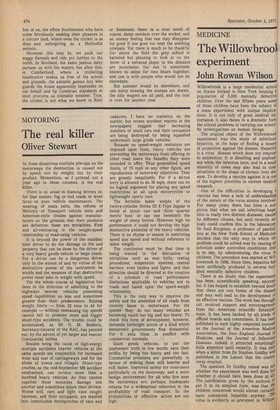The real killer
Oliver Stewart
In these disastrous multiple pile-ups on the motorways the destruction is caused not by speed; not by weight; but by their product. Momentum, as I pointed out a year ago in these columns, is the real killer.
There is no sense in blaming drivers or, for that matter, fog or bad roads or worn tyres or pool vehicle maintenance. The wearing of seats belts, the reform of Ministry of Transport vehicle tests and American-style tirades against manufacturers on the grounds that their products are defective: these are trivialities. First and all-embracing is the weight-speed relationship of road-using vehicles.
It is beyond the power of the maddest mini driver to do the damage to life and property that can be done by the driver of a very heavy goods vehicle or large coach. For a driver can be a dangerous driver only to the extent of and by virtue of the destructive power of the instrument he wields and the measure of that destructive power must take in weight with speed.
Yet the whole course of legislation has been in the direction of admitting to the highways heavier vehicles possessing speed capabilities no less and sometimes greater than their predecessors. Raising weight limits — from 32 tons to 44 for example — without restraining top speeds cannot fail to promote more and bigger shunt-type accidents. The trouble could be accentuated, as Mr N. M. Baldwin, Secretary-General of the RAC, has pointed out, by the advent of yet larger and heavier Continental lorries.
Besides being the cause of high-energy multiple accidents heavier vehicles at the same speeds are responsible for increased wear and tear of carriageways and for the abuse of towns and villages. Shunt-type crashes, as the mid-September M6 accident emphasised, can involve more than a hundred heavy vehicles, As they cannon together these monsters damage one another and sometimes injure their drivers. Worse still, cars and light vans caught between, and their occupants, are mashed into inextricable hotchpotches of cars and cadavers. I have no statistics on the matter, but recent accident reports in the newspapers suggest that increasing numbers of small cars and their occupants are being destroyed by being squashed underneath large goods vehicles.
Because no speed-weight restraints are imposed upon them, heavy vehicles are preventing the motorways from offering to other road users the benefits they were intended to offer. Thus generalised speed limits, of 70 mph or any other figure, are repudiations of motorway objectives. They are grossly inequitable. For if a 40-ton lorry is allowed to do 30 mph, there can be no logical argument for placing any speed restrictions at all upon motorcycles or lightweight sports cars.
The kerbside laden weight of the twelve-cylinder Series III E-Type Jaguar is listed at about one and three quarter metric tons or say one twentieth the weight of many lorries. However high its performance it could not develop the high destructive potential of the heavy vehicles. There is no rhyme or reason in restricting speed qua speed and without reference to laden weight.
The conclusion must be that time is being wasted in the discussion of trivialities such as seat belts, testing procedures, suspension systems, central barriers, even brakes and lights, and that attention should be directed at the creation of a schedule of road performance limitations applicable to vehicles not to roads and based upon the speed-weight relationship.
This is the only way to improve the safety and the amenities of all roads from country lanes to motorways. For the speeds they do too many vehicles are becoming much too big and too heavy. To check this form of development, however, demands forthright action of a kind which democratic governments find distasteful. For it puts them in conflict with commercial interests.
Giant goods vehicles, to put the unpleasant truth in few words, earn their profits by being too heavy and too fast. Commercial pressures are powerfully in favour of making them still heavier and still faster. Improved safety for road-users particularly on the motorway, and a more benign environment for all who live near the motorways are, perhaps, inadequate returns for a widespread reduction in the profitability of road transport. So the probabilities of effective action are not high,
































 Previous page
Previous page